1971 Rover P6 3500S
Mike Finnis aspired to a Rover P6 3500S years ago, so Classic Cars gives him one for a day to see if it lives up to the legend.
Words ANDREW NOAKES
Photography JONATHAN FLEETWOOD
‘I like all these quirky touches – it could only ever be a Rover
Fittingly, this lucky reader’s Rover drive landed on the right page
The List
Reader Mike Finnis samples Seventies status with a Rover P6B 3500S drive
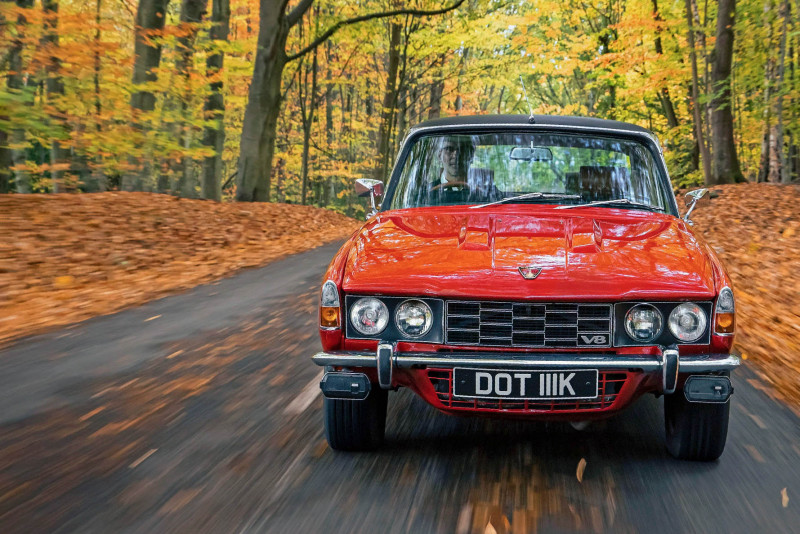
Cool cars of your childhood often turn into desirable classics a couple of decades later. That’s certainly true for CC reader Mike Finnis, whose dream car list includes a mix of British and European coupés and sports cars along with one of the finest fast saloons of the Seventies, the V8 P6. ‘The 3500 was the performance saloon to aspire to when I started driving,’ says Mike.
‘You could very comfortably drive the Rover every day’
‘It’s one of those cars that you thought at the time, “I’d like to have one of those one day.”’ Well, just for one day we’re making that dream come true, because Mike is about to get behind the wheel of one of the most sought-after P6s – the manual-gearbox, high-compression 3500S. The Rover’s owner, Will Lucy, meets us in Aldershot under an imposing statue of the Duke of Wellington. He reveals that his car is one of the first few hundred built after the model’s launch in 1971, three years on from the debut of the auto-only 3500 and a year or so after the introduction of the Series II P6s with their plastic egg-box grilles and updated instruments.
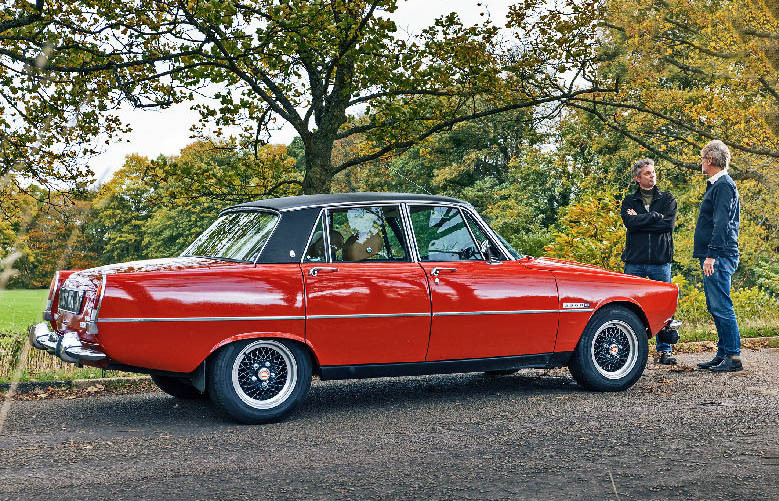
Mike’s first impressions of the Rover are mixed. ‘The doors are small, and the quarterlights are old fashioned,’ he says as he gets in. The original Citroën DS-inspired P6 was launched in 1963 and though it looked modern at the time it aged rapidly in a fast-changing era that saw car design trends swing from homely curves and chrome to squared-off shapes and matt black. The P6 eschewed the handsome but old-school wood interior trim of the P5 in favour of a material forged in the white heat of modern technology – wood-grained Formica. ‘It looked futuristic then but just seems a bit cheap and nasty now,’ Mike concedes. ‘The cabin feels snug rather than spacious, but in fact there’s plenty of room for me,’ he says as he settles his six-foot- plus frame into the driver’s seat. Mike has no trouble getting comfortable behind the wheel thanks to a seat with rake adjustment at the pull of a lever down by the seat base.
‘The classic white-on- black instruments look attractive and they’re very legible’
The substantial head restraints – dubbed the ‘ET’ type by P6 aficionados because of their shape – are adjustable fore and aft. ‘It has a safety steering column and the steering wheel is adjustable up and down. How many cars had that in 1971?’ Mike’s impressed by the layout of the instruments up ahead, nestled in a neat binnacle in front of the driver and sitting on top of the main dashboard. ‘The SD1 that came after had a similar sort of concept, so Rover must have thought it was successful.’ He’s full of praise for the switches and knobs on the dashboard, which were designed to feel distinctive under the fingers so they could be recognised by touch alone. ‘I think the safety switchgear is great, and the layout reminds me very much of a BMW 2002, or even an early-Eighties 5 Series, with all the controls to hand. Ergonomically it’s well laid out, everything’s instinctively in the right place. It’s better than some modern cars. I just like all these quirky touches – it’s character isn’t it? Everything is fed into a computer these days, and they all come out with the same solution. They’re all very competent, but they’re clones. This could only ever be a Rover, like a Jaguar of that era could only ever be a Jaguar.’
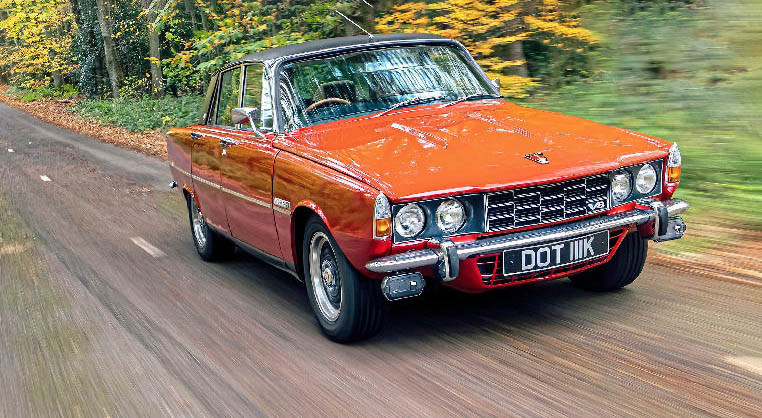
Mike fires up the 3.5-litre V8 engine, and we burble out onto the roads around Aldershot. He’s soon enthusing about the car. ‘Within a mile or two you’re perfectly happy, which says something about it. The best bit is the V8, because it sounds lovely. It’s not going to snap your neck but it’s got nice performance, with all that torque. It will pull in fourth gear from 1000rpm without any protest. It doesn’t matter a lot if you’re in the wrong gear. It’s lazy and comfortable to drive, but with a bit of a sporting character in terms of its grip and agility, and it’s quick enough to be comfortable in modern traffic.’
In high-compression (10.5:1) form the V8 was intended to run on the 101-octane Super Premium five-star petrol that was widely available in 1971, but was disappearing from filling station forecourts by the late Seventies. Will runs it on the highest-octane fuel he can find, and has tweaked the ignition timing, but Mike and I can still hear the V8 pinking occasionally. ‘That engine had been around for a few years in America, but it was quite a modern engine by British standards,’ Mike says. ‘It’s all aluminium and weighed the same as the Rover four-cylinder in the 2000 and 2200, boosting the P6’s power-to-weight ratio.’
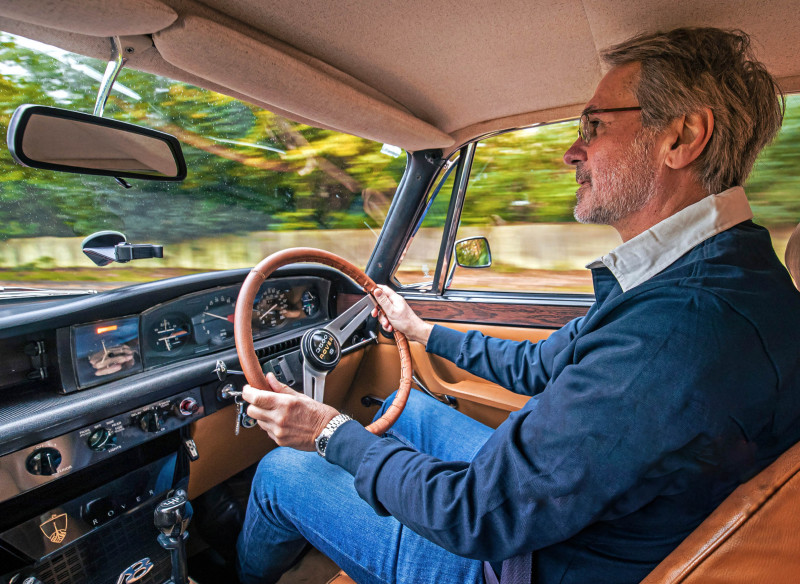
We stop to take a look under the bonnet, marvelling at how the V8 fills every inch of the engine bay. It’s actually quite narrow thanks to the fat inner wings needed to accommodate the unusual front suspension arrangement with a curious bellcrank system and springs mounted horizontally, feeding loads into the bulkhead. The battery had to be moved into the boot to make space for the wider vee engine. The two bulges in the bonnet that were added on V8 cars are just for show, though.
‘The cabin feels snug rather than spacious, but in fact there’s plenty of room for me’
Mike’s pleased that this car is a manual-gearbox 3500S rather than the more common 3500 with its three-speed Borg Warner35 automatic. ‘I find the acceleration with autos of that era was often a bit all or nothing,’ he says. ‘They’re a bit sluggish, so you press the accelerator a bit more, and a bit more – then suddenly it kicks down. The great advantage of the manual is that you can just select whatever gear you want, when you want it. The auto probably suits the car, but it’s nice to have that extra bit of involvement.’ In period the manual 3500S was reckoned to be a fair bit quicker than the automatic car, knocking a good second off the 0-60mph time; it was more economical too. Will tells us he’s seen 30mpg on a run in his 3500S, which is impressive for a 3.5-litre saloon designed before the oil crises of the Seventies forced even the well-heeled to take fuel economy seriously.

That said, a big factor in this Rover’s cruising economy is that it is fitted with a non-original five-speed gearbox, the LT77 unit (referring to the 77mm distance between the shaft centres) used in the Rover SD1, Jaguar XJ Series III, Triumph TR7 and several other applications. Today it’s a common modification for the P6. ‘The original gearbox was a weak spot,’ Will tells us. ‘It was designed for the four-cylinder P6 and toughened for the V8 with a stronger casing, better bearings, shot-peened gears and the addition of an internal oil pump to improve lubrication. But the gearing is too short, so at motorway speeds the engine is screaming when there’s no need. Those gearboxes are also known for jumping out of reverse and the torque of the V8s would blow them up.’ It’s increasingly difficult and expensive to get parts to rebuild the original four-speed units, while the 77mm five-speed is plentiful. TR7 ’boxes are preferred, apparently, because they tend to be in better condition due to the lower torque output of the Triumph engine.

‘It should have been a five-speed to begin with,’ Mike says. ‘Either that or it should have had overdrive like the Triumph saloons of the same era. The four-speeder would be fine on the A-roads we’re driving on, but for motorway cruising it would have been a bit wearing. It’s got this big V8 with lots of torque, it doesn’t need to be turning over very fast to cruise along.’ The five-speed is fairly foolproof in use, with a smooth if sometimes ponderous change. ‘It has a long travel fore and aft, but the gates for third and fifth are close together,’ Mike says. ‘You need to take care to avoid selecting the wrong ratio, but you soon get used to it. The clutch is weighty, but it’s not too bad – it’s noheavier than my TR6. The Rover’s an easy car to live with and you could very comfortably drive it every day. You forget you’re in an old car – it’s 52 years old, and the design is over 60.’
Adding to the P6’s usability is its sophisticated running gear. There’s that novel independent suspension arrangement at the front, while at the back the P6 had a Lancia-style de Dion rear end where lesser rivals still rode on a leaf-spring live axle. The de Dion reduced unsprung weight compared to a conventional axle and improved control over wheel camber for more consistent roadholding. ‘Most cars of this size and era had nothing like the ride over the bumps, and nothing like the handling either,’ Mike says. ‘It rolls a bit, but it always feels secure and the power steering is very precise and free from play, which adds to the car’s modern feel. The steering is nicely weighted on the road and light when manoeuvring – parking is no problem at all. The brakes are discs all round and they feel strong and reassuring.’
As a driving experience the Rover lives up to Mike’s dreams, but he’s wary of the P6’s potential for ownership nightmares. ‘From a maintenance perspective the construction of the car, with its unstressed bolt-on panels, can be problematic. If you had a prang you could take a damaged panel off and put a new one on. That’s probably fine until it’s five years old. Then when it starts to go rusty underneath all of those horrors are hidden and you don’t know what’s going on. Mind you, most cars of the era rusted as you looked at them. The Alfasud, for instance – they would rust on the dealer forecourt when new.’ Balancing that there’s a wealth of support from specialists and active clubs.
Mike’s adamant that the 3500S still deserves its place in his list of dream classics. ‘It feels modern, or ahead of its time, and that’s what makes it so usable today. That’s proven by the fact that you can sit in this 52-year old car and think, “I could take this to work every day and it would do fine.” What other cars of the era would you think that about? Yet it’s still old fashioned enough to involve you and not be a little bit remote from everything that’s happening, like some modern cars are. It’s old enough to have a bit of character and interest.’
Thanks to: The Rover P6 Club (p6club.com)
Modern-day usability keeps P6 in Mike’s dream garage, despite ownership hurdles.
TECHNICAL DATA 1971 Rover P6 3500S
- Engine 3528cc V8, ohv, two SU HIF6 carburettors
- Max Power 152bhp @ 5000rpm
- Max Torque 203lb ft @ 2750rpm
- Steering Power-assisted cam and roller
- Suspension Front: independent, wishbones, top links, coil springs, telescopic dampers, anti-roll bar. Rear: de Dion, leading and trailing arms, coil springs, telescopic dampers
- Brakes Front: discs. Rear: inboard discs. Servo-assisted
- Performance Top speed: 125mph
- Acceleration 0-60mph: 9.0sec
- Weight 1351kg (2979lb)
- Fuel consumption 24mpg
- Cost new £1988 in 1971
- Classic Cars Price Guide £2250-£10,500
Only a clever suspension layout allowed the V8 to fit 152bhp output is modest, but peak torque is made 2750rpm.
Modern-day usability keeps P6 in Mike’s dream garage, despite ownership hurdles.
Mike appreciates the tactility of the Rover’s switchgear. Rich leather and thick carpet meets black plastic and Formica woodgrain.


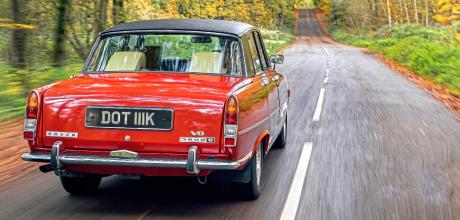
The Rover P6 was a series of mid-sized luxury saloon cars produced by British car manufacturer Rover between 1963 and 1977. The P6 was marketed as the Rover 2000 and Rover 3500, with the latter being the more powerful version.
The Rover P6 was known for its innovative design, which included a unitary body construction, a De Dion rear suspension system, and disc brakes all round. The P6 was also one of the first cars to feature a safety glass windscreen.
The Rover 2000 had a 2.0-liter engine that produced 90 horsepower, while the Rover 3500 had a 3.5-liter V8 engine that produced 155 horsepower. The car also featured a four-speed manual transmission or a three-speed automatic transmission.
In terms of performance, the Rover P6 was a capable and comfortable car. The Rover 3500 Automatic could accelerate from 0 to 60 mph in 10.5 seconds and had a top speed of 118 mph, making it one of the fastest cars of its time.
Overall, the Rover P6 was a well-regarded car that offered a comfortable and luxurious driving experience. Its innovative design and advanced features made it popular among car enthusiasts, and it remains a classic car today.
Rovers Regret
The words of your reader chimed with me. I'm lucky to be old enough to have owned a Rover P6 first time around – a 1972, 93k-mile example that I bought in 1982. The V8 was the attraction but the abiding memory is of a car that was a joy to drive, coupled with a feeling that every trip was an adventure tinged with slight anxiety – would we actually make it? Of course we did, every time. But the character remained – flickering oil light, a thirst for coolant, optically clear inner wings and that rear suspension member whose rustedthrough anchor point provided an early rear-wheel steering effect.
Looking back over the 30-odd cars I have so far owned, from Jag to Smart ForTwo, the P6 provides the biggest aftersell regret. What a fabulous car! Even now it has so many styling features that, in my opinion, no other car has ever provided. And maybe there is a second regret – I saw a yellow SD1 (yes, with the orange seats) for sale in near perfect condition at an independent dealer in the mid Eighties for (if memory serves) £1600. How I wish I had bought it.